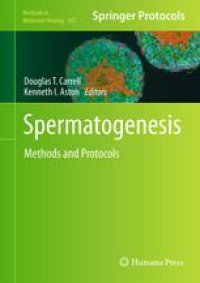
Ebook: Spermatogenesis: Methods and Protocols
- Genre: Biology // Molecular
- Tags: Cell Biology, Embryology, Developmental Biology
- Series: Methods in Molecular Biology 927
- Year: 2013
- Publisher: Humana Press
- Edition: 1
- Language: English
- pdf
Deficiencies in sperm function are usually the result of spermatogenic defects. Spermatogenesis is a biologically complex and essential process during which spermatogonia undergo meiotic recombination, reduction of the genome to a haploid state, and extensive cellular modifications that result in a motile cell capable of traversing the female reproductive tract, withstanding various potential assaults to viability, and finally successfully fertilizing a mature oocyte to give rise to an embryo. Defects in any step of spermatogenesis or spermatogenesis can lead to male infertility, a disease that affects approximately 5-7% of the population. Spermiogenesis and Spermatogenesis: Methods and Protocols details protocols used in the study of spermatogenesis, clinical analytical protocols, and basic techniques used in clinical andrology laboratories, such as obtaining accurate results for a sperm count, and advanced procedures, such as genome-wide genetic study tools and evaluation of nuclear proteins. Written in the successful Methods in Molecular Biology™ series format, chapters include introductions to their respective topics, lists of the necessary materials and reagents, step-by-step, readily reproducible protocols, and notes on troubleshooting and avoiding known pitfalls.
Authoritative and easily accessible, Spermiogenesis and Spermatogenesis: Methods and Protocols is unique in its breadth, and will be a useful reference for clinicians and researchers alike.
Deficiencies in sperm function are usually the result of spermatogenic defects. Spermatogenesis is a biologically complex and essential process during which spermatogonia undergo meiotic recombination, reduction of the genome to a haploid state, and extensive cellular modifications that result in a motile cell capable of traversing the female reproductive tract, withstanding various potential assaults to viability, and finally successfully fertilizing a mature oocyte to give rise to an embryo. Defects in any step of spermatogenesis or spermatogenesis can lead to male infertility, a disease that affects approximately 5-7% of the population. Spermiogenesis and Spermatogenesis: Methods and Protocols details protocols used in the study of spermatogenesis, clinical analytical protocols, and basic techniques used in clinical andrology laboratories, such as obtaining accurate results for a sperm count, and advanced procedures, such as genome-wide genetic study tools and evaluation of nuclear proteins. Written in the successful Methods in Molecular Biology™ series format, chapters include introductions to their respective topics, lists of the necessary materials and reagents, step-by-step, readily reproducible protocols, and notes on troubleshooting and avoiding known pitfalls.
Authoritative and easily accessible, Spermiogenesis and Spermatogenesis: Methods and Protocols is unique in its breadth, and will be a useful reference for clinicians and researchers alike.
Deficiencies in sperm function are usually the result of spermatogenic defects. Spermatogenesis is a biologically complex and essential process during which spermatogonia undergo meiotic recombination, reduction of the genome to a haploid state, and extensive cellular modifications that result in a motile cell capable of traversing the female reproductive tract, withstanding various potential assaults to viability, and finally successfully fertilizing a mature oocyte to give rise to an embryo. Defects in any step of spermatogenesis or spermatogenesis can lead to male infertility, a disease that affects approximately 5-7% of the population. Spermiogenesis and Spermatogenesis: Methods and Protocols details protocols used in the study of spermatogenesis, clinical analytical protocols, and basic techniques used in clinical andrology laboratories, such as obtaining accurate results for a sperm count, and advanced procedures, such as genome-wide genetic study tools and evaluation of nuclear proteins. Written in the successful Methods in Molecular Biology™ series format, chapters include introductions to their respective topics, lists of the necessary materials and reagents, step-by-step, readily reproducible protocols, and notes on troubleshooting and avoiding known pitfalls.
Authoritative and easily accessible, Spermiogenesis and Spermatogenesis: Methods and Protocols is unique in its breadth, and will be a useful reference for clinicians and researchers alike.
Content:
Front Matter....Pages i-xvii
Front Matter....Pages 1-1
Front Matter....Pages 3-12
Front Matter....Pages 13-19
Front Matter....Pages 21-25
Front Matter....Pages 27-37
Front Matter....Pages 39-50
Front Matter....Pages 51-60
Front Matter....Pages 61-75
Front Matter....Pages 77-87
Front Matter....Pages 89-89
Front Matter....Pages 91-102
Front Matter....Pages 103-111
Back Matter....Pages 113-118
....Pages 119-119